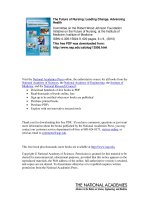Supervisor development course 21 leading change
Bạn đang xem bản rút gọn của tài liệu. Xem và tải ngay bản đầy đủ của tài liệu tại đây (17.27 MB, 66 trang )
Summary of Comments on
Leading_Change_printable.pdf
This page contains no comments
This page contains no comments
This page contains no comments
This page contains no comments
This page contains no comments
Page: 6
Author: AMSC Subject: Sticky Note
Date: 8/29/2011 11:17:19 AM
The pace of economic, global and technological development coupled with the war on terrorism in today’s world makes
change an inevitable feature of federal organizations. In fact, this may be the only thing that does not change in today’s
climate. The success of any organization (public or private) today depends on its ability to sense and adapt to rapid
change from within and outside the organization. What worked in the past is no guarantee of success today. In fact, it
may be a prescription for failure. Therefore, it’s essential that supervisors have competency and expertise in managing
change.
The change literature indicates that somewhere between 50 to 75% of all change initiatives result in failure or achieve
less than desired results. This poor track record with leading and managing change is worrisome. Supervisors at all
levels can help enhance the overall success rate of change initiatives by following a systematic approach to the change
process.
At a basic level, when we ask employees to totally change the way they have been working, it’s like asking a basketball
team to now switch to playing golf. People are not like Playdough, where we can twist and mold them into any shape
we want. Unlike Playdough people cannot change their behaviors overnight, get smarter over the weekend, or develop
skills they do not have. Anytime you change something, it impacts people personally. You need to get them involved to
gain their support, the earlier the better. We know that employee resistance is always directly proportional to the
degree people are kept in the dark and out of the change process.
Finally, given the magnitude and constant change organizations face today, supervisors who want to be successful--in
career, in relationships, in life – must learn how to effectively manage change. We illustrate the importance of this point
by reviewing the results of a survey of 369 Army Civilian Leaders in the following frame.
This page contains no comments
This page contains no comments
This page contains no comments
This page contains no comments
This page contains no comments
This page contains no comments
Page: 13
Author: AMSC Subject: Sticky Note
Date: 8/29/2011 11:17:19 AM
Performance pressures—such as work process improvement, information system enhancements, relocation, improving
quality of products or services, cost reduction initiatives, and new procedures. For example, DOD’s approach to
acquisition, logistics, and infrastructure could be much improved. This would represent a driving force for change.
Changing demographics—as the civil service workforce ages, leaders are challenged to plan for and implement strategies for integrating a younger and
diverse workforce as well as insuring that institutional knowledge is not lost as the aging workforce retires.
New events and challenges– require changes to meet evolving mission requirements. For example, persistent conflict continues to characterize the
environment in which the Army operates. As such the Army must transform to maintain its combat edge and build resilience for future mission
requirements.
Army modernization—modernization to meet challenges in the future operating environment will continue to drive change. Adapting the generating
force size and manpower mix will be impacted by efforts to meet efficiency targets.
Other forces—the Army’s budge is shrinking; increasing use of technology; BRAC; the civilian workforce transformation-- all influence the need for
change.
This page contains no comments
This page contains no comments
This page contains no comments
This page contains no comments
This page contains no comments
This page contains no comments
This page contains no comments
Page: 21
Author: AMSC Subject: Sticky Note
Date: 8/29/2011 11:17:19 AM
Individual level
Each individual employee or manager who is impacted by a change must go through their own, personal process of change. If the change impacts five
people, then each of those five must move from their Current State through their Transition State to their own Future State.. This is the essence of change
management, supporting individuals through the required personal transitions necessary for a project or initiative to improve the performance of the
organization. Note that individuals take different amounts of time to move through the process. Later in this lesson we’ll discuss how a supervisor can
manage individual needs and concerns during the change process.
Organizational level
When it comes to managing change at the organizational level, viewing change as a process helps determine the sequencing and content of the change
management effort. This helps to ensure that the right activities are occurring at the right time, and that employees are receiving the right information
they need to move through their own personal process of change. Later in the lesson we highlight key topics important in the change process.
Key Points to Remember:
Treat the changes you manage as a process, and not as a single event or series of events.
Individuals experience change as a process. Evaluate and focus your change management activities based on where individuals are in the change process.
No one experiences the process the same.
Your organizational change management efforts need to be tied to where you are in the change process.
This page contains no comments
This page contains no comments
This page contains no comments
This page contains no comments









